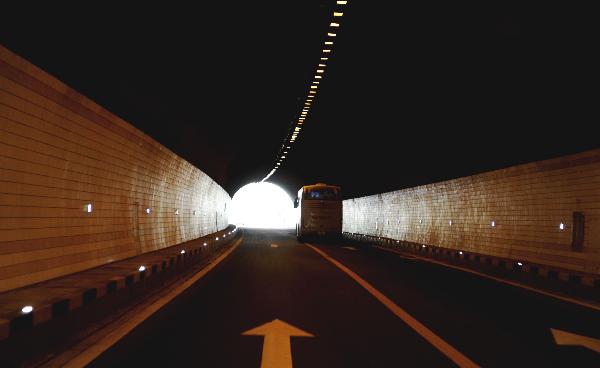Flash
Travel made easy on 'roof of the world'
Updated: 2011-07-18 06:47
(Xinhua)
LHASA - The first expressway in Tibet opened to traffic on Sunday, with Vice President Xi Jinping cutting the ribbons at the opening ceremony.
 |
|
Photo taken on July 7, 2011 shows the first expressway of Southwest China's Tibet autonomous region, in Lhasa, capital of Tibet. [Photo/Xinhua] |
The 37.8-km long, four-lane road links Lhasa's city center with Gonggar Airport in the neighboring Shannan Prefecture.
The toll-free expressway will halve the travel time from downtown Lhasa to the airport to 30 minutes.
"It will make the trip more convenient," said Yonten, 31, who has been working as driver for a company in Lhasa for three years.
In summer, when the Lhasa River swells, the old road from Lhasa to the airport could become flooded, Yonten said.
According to the driver, the old road, No. 318 National Highway, is narrow and jammed with traffic year round. "I once waited half an hour and almost missed my flight," he said.
"The new expressway will ease traffic pressure on a section of No. 318 National Highway," said Zhao Shijun, head of the transportation department of Tibet.
Construction of the expressway began in April, 2009 and was completed in early July, 11 months ahead of schedule.
The 1.59 billion yuan ($246 million) expressway has a speed limit of 120 km per hour, and its roadside lighting is powered by solar energy.
WEAVING A NETWORK
Tibet's transportation system has been rapidly developed since the region was peacefully liberated six decades ago.
The Information Office of the State Council published a white paper on July 11. According to the document on the 60 years since Tibet's peaceful liberation, in the old days, there was not a single highway in the region.
Construction of the Sichuan-Tibet road started immediately after the liberation. Ma Chengshan, then chief of staff in the army, recalled that the task was "urgent."
The late Chairman Mao Zedong told them not to disturb the local people, so the soldiers had to dig edible wild herbs and catch mice to eat.
"The snow was so deep that it sometimes reached the waist of the soldiers," Ma said. "We worked from dawn to dusk, our clothes were always wet."
Due to the bad climate and geographic disasters, many soldiers died along the way. "Under every meter of the road there lies a soldier," Ma said.
The 2,413-km road, together with another linking Qinghai and Tibet, opened in 1954.
Today, "all townships and more than 80 percent of the administrative villages in Tibet have gained access to highways, which now total 58,200 km," according to the white paper from the Information office.
The comprehensive road network is changing people's lives.
Cuddling her baby in her arms, 23-year-old Tsering Lhamo said she's thankful to a new road, which opened in her village Naiyu in Mainling County, Nyingchi last year.
"In the past, there was only one rugged road in our village," she said. The cobbled road was a cattle track. Traveling on it normally took villagers a day to reach the county seat.
Many pregnant women delivered on the way to hospital, while some others miscarried. More chose to give birth to their babies at home, but without proper sanitation, it could be dangerous.
"My elder sister delivered at home, but the baby died," Tsering Lhamo recalled bitterly.
It only took Tsering Lhamo's husband two hours to drive her to the county hospital on the newly built road
"It was a boy, very healthy," she smiled.
China's last isolated county is soon to be connected to the country's highway network with the completion and operation of the Galungla tunnel on the Metok Highway last December. The road is set to be completed next year.
Improvement of road conditions has gone hand in hand with a rise in the number of automobiles. By last September, Tibet had a total of 216,478 automobiles. Its per capita ownership ranked third in China.
ROAD TO HEAVEN
"This is an amazing road to heaven, carrying us to paradise." The Tibetan-styled song, namely Road to Heaven, is often heard in stores and taxis in downtown Lhasa.
Dubbed the "road to heaven," the 1,956-km rail link running from Golmud in the northwestern Qinghai Province to Tibet's regional capital Lhasa was opened on July 1, 2006.
The next year, Drakpa Yonten, a herder in the Gyaidar Village in the Damxung County, opened an agritainment restaurant.
He set up three big tents and several smaller ones on the grassland, where people could taste traditional Tibetan dishes.
"I came up with this idea after completion of the Qinghai-Tibet Railway," he said.
The railway brought more tourists to Tibet. Drakpa Yonten found that many tourists stopped on the grassland, having a stroll or taking photos of the trains and snow-capped mountains in the distance.
Summer is the best season for business for the Tibetan herder. "We receive 30 to 40 tourists a day and the monthly income can reach 1,000 yuan."
"We have been herders for generations and never did business before," Drakpa Yonten said. "It's the railway that gave us the opportunity."

Specials

China-US Governors Forum
The first China-US Governors Forum is held July 15 in the Salt Lake City, the United States.

My China story
Foreign readers are invited to share your China stories.

Rare earths export quota
China kept its export quota at almost the same level as last year.
